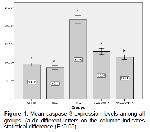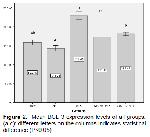Chemicals: MTX (50 mg/5 mL, injectable solution, Koçak Farma, İstanbul, Turkey) was purchased from a pharmacy. NRG and other chemicals (Sigma-Aldrich Co., USA) were analytical purities.
Experimental Design: A total of 35 adult male Sprague-Dawley rats (220-250 g weighed) were used as materials. They were obtained from Atatürk University, Experimental Research Centre and held under standard laboratory conditions (%45 humidity, 24 °C, 12 h light, 12 h dark period). Ethical board approval was taken from Local Animal Care Committee of Atatürk University.
They were divided into 5 groups 7 rats in each;
Group 1 (Control): Received a single dose injection of physiological saline intraperitoneally on the first day.
Group 2 (NRG 100): Received orally NRG (100 mg/kg b.w./ day) for 7 days.
Group 3 (MTX): Received single dose of 20 mg/kg of MTX intraperitoneally on the first day.
Group 4 (NRG 50+MTX): Received 50 mg/kg/day NRG for 7 days after a single intraperitoneal injection of 20 mg/kg MTX.
Group 5 (NRG 100+MTX): Received 100 mg/kg/day NRG for 7 days after a single intraperitoneal injection of 20 mg/kg MTX.
All animals were sacrificed the next day following the last treatment under sevoflurane (Sevorane liquid 100%, Abbott Laboratory, Istanbul, Turkey) anesthesia. Blood samples were collected from V. jugularis and then transferred into clean dry test tubes. Blood samples were centrifuged at 900 g for 10 min at 4 °C. The testes were separated and cleaned from connective and adipose tissue by anatomical scissors and stored at 20 °C for biochemical analysis.
Oxidative Parameters of Testicular Tissue: The malondialdehyde (MDA) level in testes was determined according to the method of Placer et al. 13 and expressed as nmol/g tissue. The superoxide dismutase (SOD) activity of the testes was assayed by the method of Sun et al. 14 and expressed as U/g protein. The catalase (CAT) activity of the testes was determined according to the method of Aebi 15 as expressed as katal/g protein. Glutathione (GSH) (nmol/g tissue) was evaluated with regard to the method of Sedlak and Lindsay 16 The glutathione peroxidase (GSH-Px) activity was calculated by the method of Lawrence and Burk (17) and expressed as U/g protein. The protein content of the supernatant was determined using the method described by Lowry et al. 18.
Apoptosis and Autophagy Evaluations: Caspase-3 (an apoptosis indicator) activity was determined in testes homogenate by using an enzyme-linked immunosorbent assay kit (rat caspase-3 ELISA kit, Cusabio) by following to the manufacturers protocol. BCL-3 (an autophagy indicator) level was determined by using rat ELISA kit (Sunred Biological Tecnology, Shangai, China). The plates were read at 450 nm via the ELISA microplate reader.
Statistical Analyses: All parameters were expressed as mean value ± standard error of means (SEM). The difference was accepted as significant when P<0.05. For the comparison of group values, analysis of variance (One-way ANOVA) in IBM SPSS program (Version 20.0, IBM Co. North Castle, New York, USA) was used. Post hoc Tukey test was used for comparisons among all groups.





